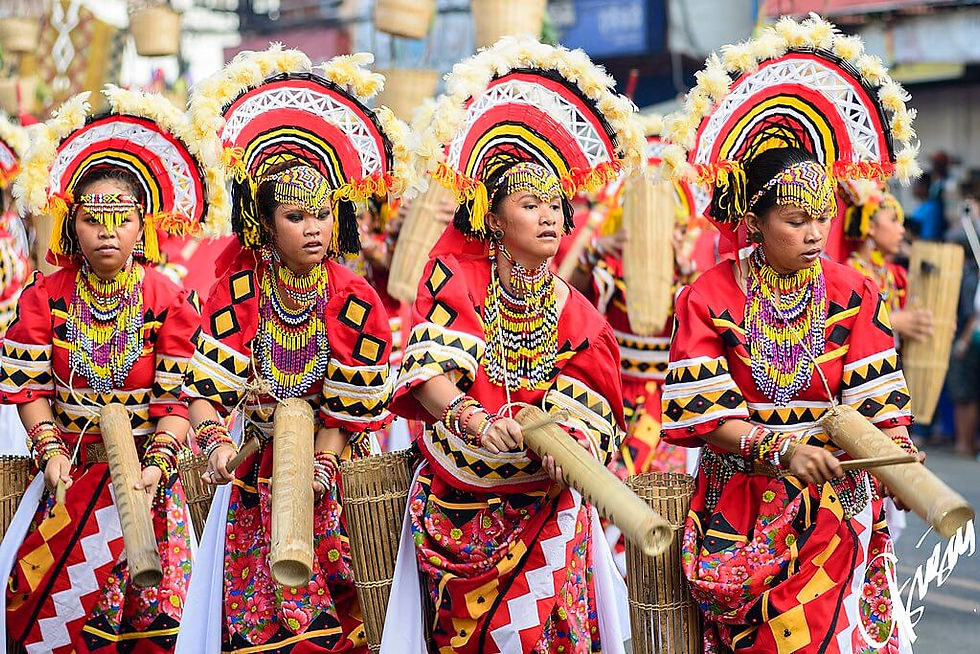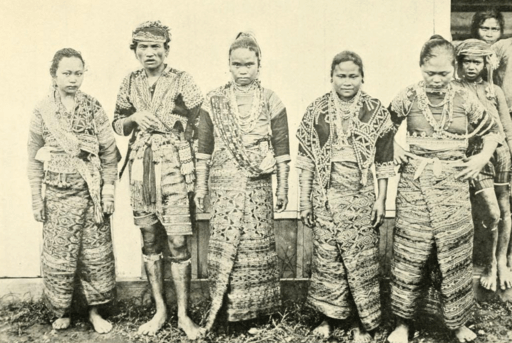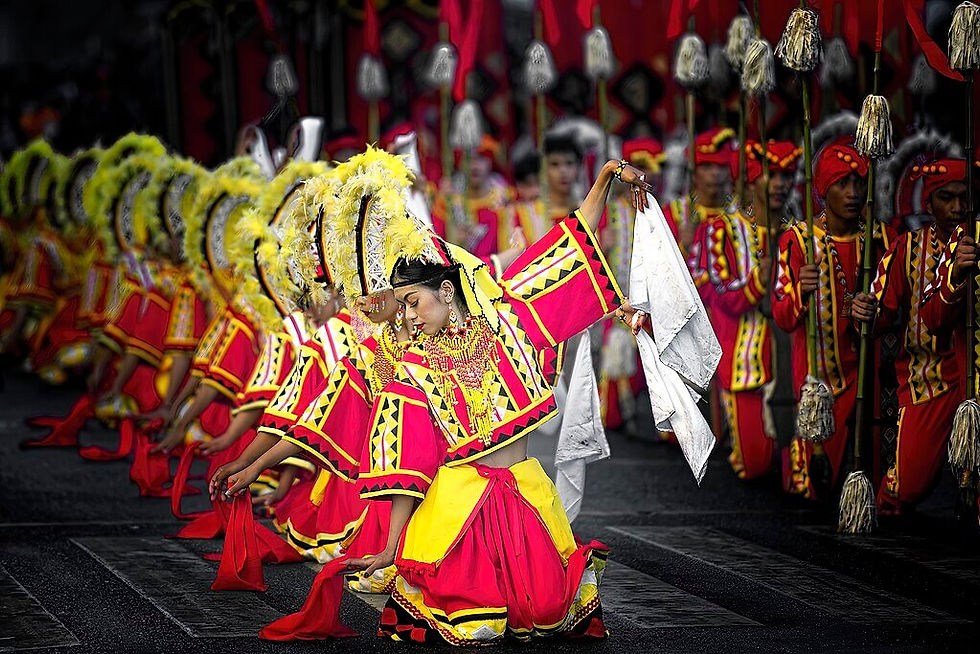Lumad - Tradition and Culture
- KGM Resorts
- Jul 31
- 9 min read
Guardians of Mindanao’s Ancestral Lands

The word “Lumad” comes from the Visayan term meaning “native” or “indigenous.” It is a collective identity chosen by more than 18 non-Muslim ethnolinguistic groups in Mindanao to distinguish themselves from the region’s Christian settlers and Muslim communities. These groups include the Manobo, Higaonon, Bagobo, T’boli, Subanen, and many others—each with their own distinct languages, customs, and ancestral domains.
But to speak of the Lumad solely in the past tense would be a mistake.
The Lumad are not relics of a bygone era—they are living cultures, resilient communities, and guardians of ancestral wisdom. From forest stewardship to spiritual ceremonies, from oral epics to woven artistry, the Lumad embody a heritage deeply rooted in the land. Yet today, they also stand at the crossroads of development, displacement, and identity.
To know the Lumad is to recognize an enduring thread in the Philippine cultural tapestry—a people whose voice must not be lost in the noise of modernity.
Ethnolinguistic Diversity of the Lumad
The term “Lumad” encompasses a remarkable mosaic of over 18 distinct indigenous groups spread across the highlands and river basins of Mindanao. Each group carries its own language, customs, governance structures, and spiritual traditions—making the Lumad not a single identity, but a constellation of cultures.
Here are some of the major Lumad ethnolinguistic groups:
Manobo – The largest Lumad group, occupying vast areas from Agusan to Cotabato.
Higaonon – Found in the mountains of Bukidnon and Misamis Oriental, known for their peacekeeping traditions.
Subanen – Inhabit the Zamboanga Peninsula, often residing in forested highland communities.
Bagobo – Settled in Davao del Sur and parts of Mt. Apo, recognized for intricate textiles and weaponry.
T’boli – From South Cotabato, famed for their t’nalak weaving and rich musical traditions.
Teduray – Native to Maguindanao’s highlands, preserving a unique cosmology and justice system.
Ata (or Ata-Manobo) – Residing in areas of Davao and Bukidnon, with a deep knowledge of forest ecology.
Mandaya – Based in Davao Oriental and Compostela Valley, known for elaborate traditional attire.
These groups are scattered across Northern, Central, and Southern Mindanao, often in ancestral lands passed down through generations. Despite modernization, many maintain traditional governance systems, such as the Datu or council of elders, who guide decisions in accordance with tribal laws.
The linguistic, artistic, and spiritual diversity of the Lumad people is a testament to the complexity of indigenous Mindanao—proof that Filipino identity is not monolithic, but plural and deeply rooted in regional heritage.

Ancestral Lands and Connection to Nature
For the Lumad, ancestral land—known in Filipino as katutubong lupa—is far more than territory. It is identity, spirit, and survival bound together in one living landscape. The forests, rivers, mountains, and fields are not just resources—they are sacred relatives, woven into the very fabric of Lumad culture.
Their ancestral domains, passed down through oral tradition and communal stewardship, are home to generations of rituals, hunting trails, burial grounds, and sacred sites. These lands provide not only food and shelter, but also the setting for the Lumad’s spiritual and social life.
The forest is a pharmacy and pantry, yielding medicinal plants, fruits, wild game, and building materials.
Rivers and springs are revered, often believed to be inhabited by spirits or guarded by unseen beings.
Mountains serve as spiritual beacons, places of prayer, pilgrimage, and ancestral guidance.
The Lumad possess deep traditional ecological knowledge developed over centuries—farming methods like swidden agriculture (kaingin), natural pest control, herbal medicine, and rainwater harvesting. Their relationship with nature is one of balance and reciprocity, guided by unwritten laws that prioritize sustainability, respect, and collective well-being.
To displace the Lumad from their land is to tear away the roots of their wisdom and identity. Protecting their ancestral domains is not just a matter of land rights—it is an act of cultural survival.
Cultural Traditions and Way of Life
The Lumad people's way of life reflects a deep harmony with nature, a rich oral tradition, and a communal social structure that has thrived for generations. Their cultural expressions are both artistic and functional, rooted in ancestral knowledge and collective identity.
Music and Oral Tradition
Lumad communities use instruments like the kulintang (gong ensemble), agong (large hanging gong), and bamboo flutes to accompany chants, dances, and epics. Oral storytelling remains vital, preserving myths, histories, and moral lessons across generations.
Weaving and Body Art
Many Lumad groups are renowned for their intricate weaving, beadwork, and traditional tattoos, which often signify status, bravery, or tribal affiliation. Patterns and colors carry symbolic meanings, passed down from mothers to daughters.
Food and Livelihood
Living in upland and forested areas, the Lumad rely on swidden farming, kaingin, hunting, fishing, and rice terracing. Their diet includes root crops, wild game, and fruits—always in line with seasonal rhythms and sustainable practices.
Community and Leadership
The Datu or chieftain leads with the support of tribal councils, mediating disputes, guiding rituals, and ensuring harmony with both nature and neighboring tribes. Elders and spiritual leaders (like babaylan) also hold deep influence.
Their culture is not static, but adaptive and alive, resilient in the face of change while holding fast to centuries-old wisdom.

Festivals and Rituals
The Lumad celebrate their culture through vibrant festivals and sacred rituals that honor both the physical and spiritual cycles of life. These gatherings are deeply rooted in ancestral traditions, serving as a living expression of their identity, beliefs, and connection to the land.
Kalimudan Festival (Sultan Kudarat)
Held every November, this celebration brings together the diverse indigenous groups of the province, including many Lumad communities, to showcase their traditional music, dances, and crafts in a grand cultural convergence.
Kaamulan Festival (Bukidnon)
A highlight of Mindanao’s cultural calendar, Kaamulan is a gathering of Bukidnon’s seven indigenous tribes. It features age-old rituals, tribal weddings, peace pact ceremonies (paghuya), and offerings to ancestral spirits—a rare glimpse into Lumad spirituality and governance.
T'boli Tribal Festival (South Cotabato)
Also known as Lemlunay, this annual event celebrates the artistry and spiritual heritage of the T’boli people. Dancers clad in t’nalak fabric move to the beat of gongs, while sacred rites are performed to bless the land and its people.
Across Lumad communities, rituals mark important life events and seasonal changes—from planting and harvest (pananum and ani) to healing ceremonies led by babaylans (spiritual leaders). Peace pacts, known as paghuya, are sacred moments of diplomacy, often sealed through shared rituals, chants, and symbolic exchanges.
While most Lumad spiritual practices are animist in origin—honoring nature spirits, ancestors, and deities—many communities have also integrated Christian beliefs, creating a unique form of syncretic spirituality that blends tradition with adaptation.
These festivals and rituals are not just performances—they are acts of remembrance and resistance, keeping Lumad identity alive in a rapidly modernizing world.
Challenges Faced by the Lumad
Despite their rich cultural heritage and deep connection to the land, the Lumad face ongoing struggles that threaten their very survival as distinct indigenous communities. These challenges are both systemic and deeply rooted in the broader context of resource exploitation and marginalization.
Land Dispossession and Resource Extraction
Many Lumad communities reside on mineral-rich ancestral lands that have been targeted by large-scale mining and logging operations. These extractive activities have led to deforestation, pollution of waterways, and the degradation of sacred sites, displacing tribes from lands they have inhabited for centuries.
Militarization and Forced Displacement
In areas marked as “conflict zones,” Lumad communities are frequently caught in the crossfire between government forces and armed insurgents. Military presence in villages has led to mass evacuations, with thousands forced to live in overcrowded evacuation centers under harsh conditions, separated from their livelihoods and traditional support systems.
Struggles for Legal Recognition
Despite the Indigenous Peoples’ Rights Act (IPRA) of 1997, many Lumad tribes continue to struggle with the slow and bureaucratic process of securing Certificates of Ancestral Domain Title (CADTs). Without formal recognition, they remain vulnerable to land grabs and legal exclusion from decision-making processes affecting their territories.
Cultural Erosion and Survival
With displacement comes the erosion of traditional knowledge, language, and rituals. Youth disconnected from their roots face pressure to assimilate into mainstream culture, risking the gradual loss of their indigenous identity.
The Lumad’s fight is not only for land—it is a fight for cultural survival, dignity, and the right to self-determination. Their resilience, however, remains unbroken, as they continue to assert their rights and preserve their traditions in the face of adversity.

Preservation Efforts and Advocacy
Amid the mounting challenges, the Lumad have not stood silent. Across Mindanao and beyond, various groups—indigenous and non-indigenous alike—are working tirelessly to safeguard Lumad heritage, secure ancestral rights, and amplify their voices in the national and international stage.
Lumad Schools: Education Rooted in Culture
Alternative schools such as Alcadev (Alternative Learning Center for Agricultural and Livelihood Development) and Salugpongan Ta' Tanu Igkanogon Community Learning Center have provided community-based, culturally grounded education for Lumad children. These institutions teach not only basic literacy but also sustainable farming, Lumad history, and indigenous values—empowering youth while preserving tradition.
NGO and Faith-Based Advocacy
Non-government organizations and church-led networks have played a pivotal role in providing humanitarian support, legal assistance, and capacity-building. Groups like Save Our Schools Network advocate for the reopening of Lumad schools and protect students and teachers from harassment. Meanwhile, humanitarian missions from the Rural Missionaries of the Philippines (RMP) and other interfaith bodies offer relief and solidarity in times of crisis.
Community-Led Resistance and Peacebuilding
Despite displacement and militarization, Lumad communities continue to organize tribal councils, peace pacts (paghuya), and dialogue with stakeholders to defend their ancestral domains. These grassroots movements often combine traditional governance systems with modern legal strategies to resist exploitation and assert indigenous sovereignty.
Government Programs and Ongoing Gaps
While the Indigenous Peoples’ Rights Act (IPRA) of 1997 was a landmark policy recognizing ancestral domain and self-governance, implementation has often been slow, inconsistent, or undermined by powerful interests. Many Lumad communities still await full recognition of their ancestral titles and adequate protection from violence.
In a landscape marked by uncertainty, what endures is the resilience of the Lumad people—and the growing chorus of advocates committed to defending their right to live, learn, and lead on their own land.
How You Can Support the Lumad
Supporting the Lumad is not only about preserving culture—it’s about standing with indigenous peoples in their struggle for dignity, justice, and self-determination. Here are tangible ways you can contribute:
Support Fair-Trade Indigenous Crafts
Purchase authentic Lumad-made products such as woven textiles, beadwork, instruments, and baskets from verified cooperatives or NGOs. These crafts are not only beautiful—they carry centuries of tradition and provide much-needed livelihood for communities. Look for fair-trade certifications or organizations that return profits directly to the artisans.
Donate to Lumad Advocacy and Education Initiatives
Many grassroots schools and advocacy groups rely on donations to operate. Consider giving to organizations like Save Our Schools Network, Alcadev, or RMP (Rural Missionaries of the Philippines) that provide education, legal support, and humanitarian aid to displaced Lumad families and students.
Promote Awareness Through Responsible Travel and Storytelling
If visiting Mindanao or Lumad communities, do so with respect and consent, preferably through community-approved tours or cultural exchanges. Back home or online, use your platform—blog, social media, classroom, or workplace—to share accurate, respectful stories about Lumad heritage and issues.
Every voice matters. Whether you're a traveler, educator, artist, student, or concerned citizen—you can be part of ensuring the Lumad story continues with pride, safety, and sovereignty.

Frequently Asked Questions (FAQ)
Q: What does “Lumad” mean?
A: “Lumad” is a Visayan word meaning “native” or “indigenous.” It refers collectively to over 18 non-Muslim indigenous groups in Mindanao who share ancestral roots but maintain distinct cultures and languages.
Q: Who are some of the major Lumad groups?
A: Some prominent Lumad groups include the Manobo, Higaonon, T’boli, Bagobo, Subanen, Teduray, Mandaya, and Ata. Each tribe has its own traditions, dialects, and governance systems.
Q: Where do the Lumad live?
A: They are spread across Northern, Central, and Southern Mindanao, often in remote upland or forested areas. Their ancestral domains include parts of Bukidnon, Davao, Agusan, Cotabato, and Zamboanga Peninsula.
Q: What is the role of ancestral land in Lumad life?
A: Ancestral land is sacred. It is central to Lumad identity, spirituality, and livelihood. Forests, rivers, and mountains are not just resources but part of their community and belief system.
Q: Are Lumad traditions still practiced today?
A: Yes. Despite challenges, many Lumad groups continue to pass down music, weaving, rituals, farming, and oral history through generations. Festivals like the Kaamulan and T’boli Tribal Festival celebrate this living heritage.
Q: How can I support Lumad communities?
A: Support can include buying fair-trade indigenous crafts, donating to Lumad-led education and advocacy organizations, sharing their stories, and standing up for indigenous rights and environmental justice.
Takeaway – The Living Spirit of the Lumad
The Lumad are not relics of a distant past—they are living cultures, vibrant and vital, holding centuries of wisdom, resilience, and connection to the land. As stewards of Mindanao’s forests, rivers, and mountains, they play an irreplaceable role in preserving the Philippines’ biodiversity. Their sustainable ways of living, rooted in respect for nature and community, offer valuable lessons for a world in ecological crisis.
But their survival is under threat—from displacement and exploitation to erasure. To truly honor the Lumad is to listen to their voices, defend their right to ancestral land, and amplify their stories in our national conversation. They are not just part of Philippine identity—they are its soulkeepers.
Let us walk with them—not ahead, not behind—but alongside. In doing so, we build a more inclusive, just, and culturally rich future where no one is left unheard.
















♥️♥️♥️
Happy and resilient people, the lumads are truly the Filipinos
Rich culture and tradition being preserved and practiced to remember and honor.
Respect each one with their own distinct languages, customs, and ancestral domains.
❤️💚💜